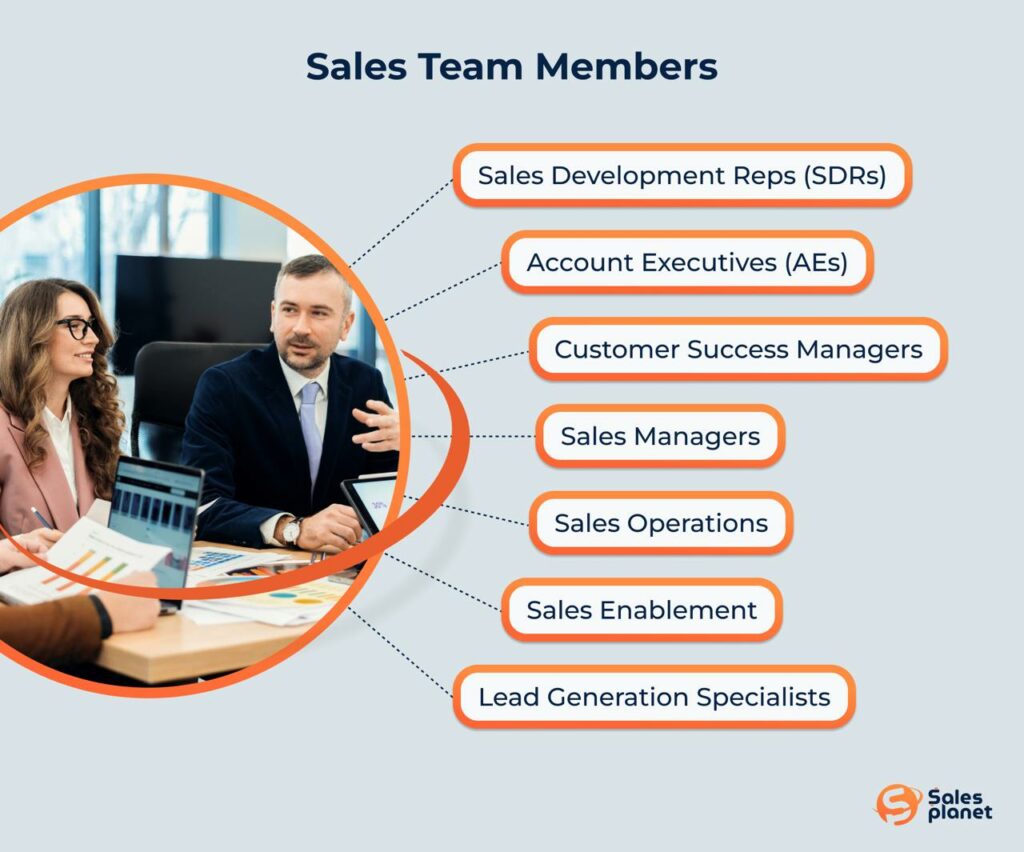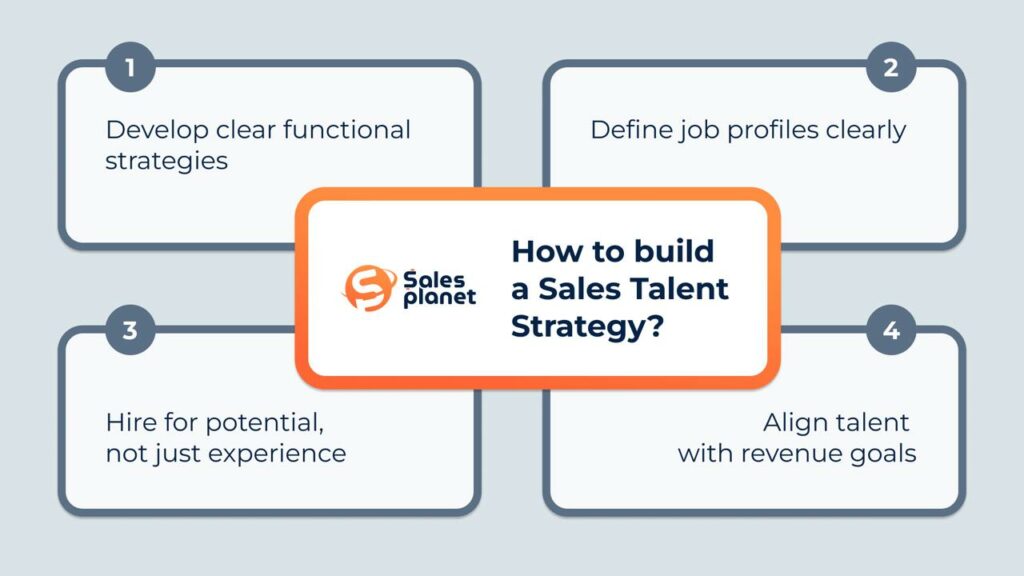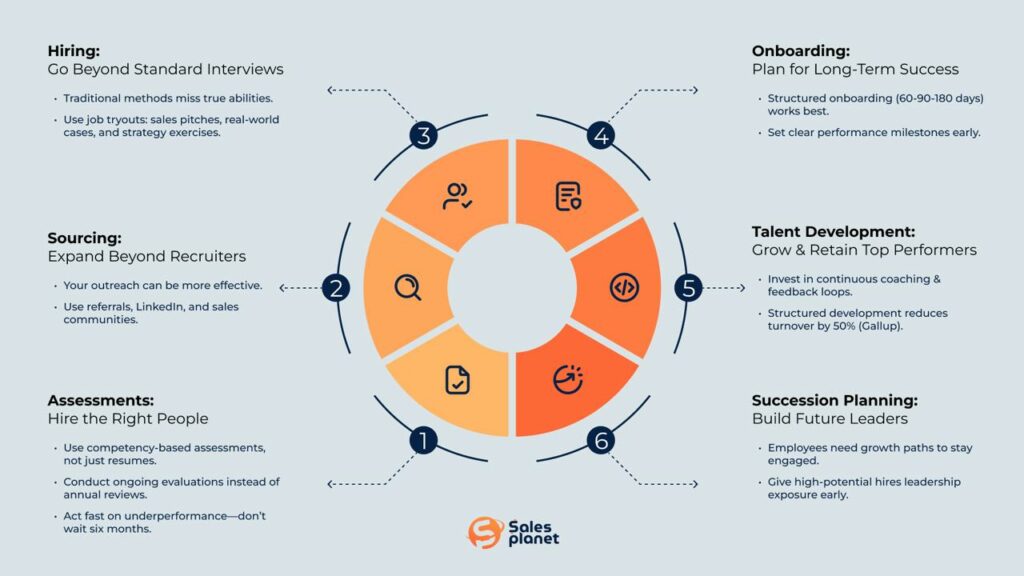
Finding the right Sales and Support specialists for your team is one of the most crucial responsibilities of every business leader. A well-selected hire can significantly boost your organization’s performance, while a poor hire can lead to lost revenue, low productivity, and high turnover costs.
According to the Society for Human Resource Management (SHRM), a bad hire can cost up to 30% of that employee’s annual salary. High-level sales roles can exceed $1M when factoring in lost deals and customer churn.
This guide will walk you through the most common hiring mistakes, best practices, and a structured approach to finding and retaining top sales talent.
The Impact of Hiring the Right (SM, AE, SDR, Ops, etc)
Hiring decisions directly impact revenue and business growth. However, many leaders default to hiring from within their industry because it seems easier and more familiar. For example, a software company Head of Sales might prefer to hire an AE with software experience, assuming they’ll ramp up faster. However, this approach can limit adaptability—especially in industries where subject-matter expertise (e.g., transportation, logistics) matters more than experience.

We’d recommend hiring for competencies—such as industry-specific skills or adaptability—should take precedence over experience alone. Yesterday’s success does not guarantee future performance, especially in rapidly changing industries.
Common Mistakes in Sales Hiring
- Choosing Industry Retreads
Many hiring managers often hire candidates with industry-specific experience, assuming they’ll ramp up quickly. However, this approach can limit potential. Top performers in a similar role may be unlikely to switch jobs unless their career growth has stagnated, which might indicate they are no longer high achievers. - Overemphasizing Role-Specific Expertise
While role-specific expertise is essential, cross-functional collaboration is equally critical. A salesperson who cannot work effectively with delivery, for instance, can create silos and disrupt team dynamics. - Hiring Based on Past Comfort
Executives sometimes hire individuals they’ve worked with before or trust from previous roles. While familiarity feels safe, it may not align with the current environment. Always prioritize skills and strategic fit over personal comfort.
The Cost of a Bad Sales Hire
A bad sales hire is more than just a wasted salary. It can lead to:
- Lost revenue: poor performers miss sales targets and lose key deals.
- Team disruption: low morale and wasted management time.
- Customer churn: bad sales experiences push customers away.
According to a report by Gallup, companies with high employee engagement see 21% higher profitability. Making the right hire from the start is critical for long-term success.
Building a Future-Focused Talent Strategy

To avoid these pitfalls, leaders should adopt a proactive approach:
- Develop Clear Functional Strategies
Functional strategies act as a roadmap for identifying the talent needed to meet future objectives. For example, if your company plans to expand into new markets, you’ll need individuals skilled in opening new geos. - Define Job Profiles Clearly
Job profiles should go beyond generic descriptions and articulate specific goals, responsibilities, and required competencies. For instance, instead of listing “experience in sales,” focus on abilities like “complex sales cycle” or “strategic account management.” - Hire for Potential, Not Just Experience
Seek candidates who can adapt to your organization’s evolving needs. Look for individuals with the curiosity and drive to learn your industry’s nuances rather than relying solely on those with past industry experience. - Align Talent with Revenue Goals
Just as a football team needs players that fit its playbook, your company requires employees aligned with their revenue goals. Ensure your hiring process emphasizes this alignment, enabling your team to perform at its peak.
Hiring is a high-stakes game that requires a forward-looking approach. Organizations can build teams capable of meeting tomorrow’s challenges by avoiding common mistakes and focusing on competencies, adaptability, and strategic alignment. With the right people in place, leaders can drive innovation, outpace competitors, and achieve long-term success.
Sales Talent Strategy: Key Steps for Success
After addressing the initial phases of hiring and onboarding, it’s essential to dive into the next stages. These stages will ensure that the talent you bring into your organization is effectively nurtured, developed, and set up for success in alignment with the sales strategy.

1. Assessments: Put the Right People in the Right Roles
When assessing talent, it’s crucial to measure whether you already have the right people within your organization and whether new hires fit into the company’s culture and needs. A more effective strategy involves assessing employees based on role profiles, focusing on competencies that align with the organization’s current and future needs.
Instead of a once-a-year meeting to discuss performance, this new approach emphasizes ongoing evaluation. For instance, evaluating a rep’s ability to meet strategic goals and targets through constant feedback will provide more valuable insights into sales. If someone is not meeting expectations, it’s time to move into development plans to improve their performance. It may signal the need to source new talent if they still can’t meet those goals. Don’t wait for ages.
2. Sourcing: Expanding Beyond Conventional Methods
Where do you find the best talent? A common mistake is leaving sourcing entirely to Recruitment. As a sales leader, participating in the sourcing process can be extremely valuable. Your personal outreach can be more effective than relying on others to bring candidates to you.
3. Hiring: Going Beyond Interviews
The conventional hiring process often includes a screening interview, followed by a series of manager interviews, and reference checks. However, this method might not reveal the true capabilities of a candidate. One innovative approach is the “job tryout,” where candidates perform real tasks in a simulated, live-action scenario. Create a real case, for example, ask them to develop a presentation for a fictional client and articulate it to your Board.
4. Onboarding: A Structured Process with Long-Term Focus
Onboarding should not be a rushed process of introducing employees to the corporate culture and HR requirements through a week of training. Instead, it should be structured around a longer-term development plan spanning 60, 90, and 180 days. The goal is to ensure employees are on the right track early, with clear progress indicators. This way, you can identify any issues within the first few months rather than six months down the road when performance expectations are not being met.
5. Talent Development: Transforming New Hires into Top Performers
Once the new hire is onboard, it’s time to develop them. This requires ongoing assessments and personalized development plans to close performance gaps. Many organizations fail to invest in developing their existing talent, which leads to dissatisfaction and turnover.
Development shouldn’t be a once-in-six-months event; it should be a continuous process of coaching and improvement. Coaching plan must be in place here and Sales Enablement plays a crucial role in support here.
6. Succession Planning: Preparing for Future Leadership
Succession planning is often overlooked, but it’s a critical element of any people’s strategy. Employees need to know that they have a future in the company; otherwise, they may feel stagnant and leave. Establishing a clear path for upward mobility can keep top performers engaged and motivated.
Letting high-potential guys experience leadership tasks and providing them with the training to become future managers can build a robust pipeline of leaders who understand the company culture and can effectively lead teams.
Avoid relying solely on “gut feel” or conventional wisdom. Instead, embrace a structured, data-driven approach that assesses competencies, fosters continuous development, and plans for the future. By doing so, you’ll be well on your way to building a world-class team capable of achieving your organization’s strategic objectives.


